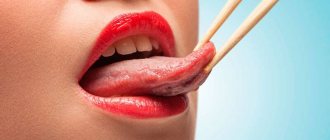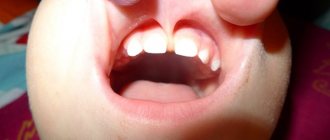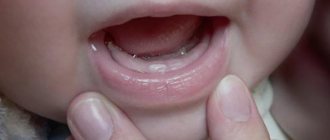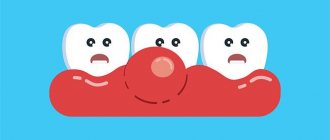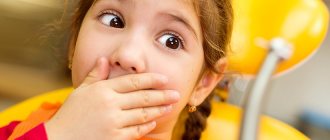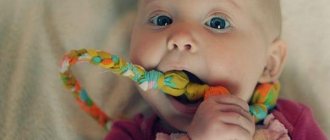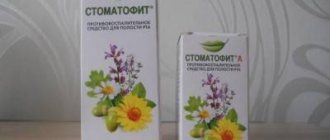Causes of rashes around the mouth in children
A rash around the mouth in a child of different ages occurs for several reasons:
- excessive salivation;
- violation of hygiene;
- infectious diseases;
- dermatitis;
- helminthic infestation;
- influence of external factors.
A rash around a child’s mouth can be caused by many factors that are important to identify for proper treatment.
Many of these causes are associated with vitamin deficiency and the use of hormonal drugs to treat certain diseases. The impetus for the spread of the rash can be a disruption of the digestive tract. This is both an imperfection of the enzymatic system and functional disorders.
Children of different ages go through several growth spurts. These are the stages of maturation of internal and endocrine organs. Therefore, a rash may appear for some period of time and go away on its own.
Environmental factors
Rash and irritation around a child's mouth often occurs if the skin is exposed to:
- wind;
- ultraviolet radiation;
- humid hot climate.
A baby's skin is very delicate, so it needs to be protected from open sunlight. The result of insolation is the appearance of red spots and rashes. If a child has increased salivation and is outdoors, then when there are gusts of wind, the skin may become chapped, reddened, and covered with dermatological elements.
The increase in symptoms occurs gradually: from the first hours, dry skin appears, then it turns red, and blisters with watery contents appear. When the climate changes or vacations in hot countries, the elements appear due to the onset of excessive work of the sebaceous glands.
Consequences of acne
Acne can cause more than just rashes. Some people believe that acne is a skin condition that eventually outgrows, but it can have a profound and lasting impact on one's life. Many people experience one or more of the following after acne appears.
Acne scars: When the breakout goes away, it leaves behind a permanent scar. Some scars cause indentations in the skin. The rest are gradually disappearing. It's impossible to predict who will develop scars after their acne goes away, but the following factors increase your risk:
- acne has been present for a long time because the teenager does not treat it or the treatment does not work;
- One or more close blood relatives have had acne in the family.
Dark spots on the skin: As acne breakouts fade, some people see the area where acne once was. This completely flat spot can be pink, red, purple, black or brown, and is often mistaken for a permanent acne scar. Source: Modern Treatments and Rehabilitation of Acne Vulgaris. Barinova A.N. Russian family doctor, 2022. p. 5-18.
Neonatal acne in newborns
Newborns include children up to 28 days of life. Some mothers notice irritation on the baby's skin during this period, which makes them worry. This condition is typical for 20-30% of children and refers to physiological phenomena.
A rash around a child’s mouth is a consequence of hormonal changes in the body, which begins to live independently.
The second reason for the phenomenon is the proliferation of yeast-like fungi on the surface of the body, which need sebum for nutrition. Externally, it is not difficult to determine that this is acne of the perinatal period. The elements are pointed, with a white shaft in the center. The contents of the vesicle are viscous, which distinguishes clear discharge from herpes infection or dermatitis.
Unlike other causes of its appearance, newborn acne migrates over the face and neck and is not typical for other parts of the body, as with urticaria and miliaria. In addition, there are no signs of intoxication, which would indicate an infectious process.
Treatment of facial acne in teenagers
The appropriate acne treatment plan depends on many factors, including:
- type of acne;
- where acne appears on the skin;
- what treatments have already been tried;
- when the rash started;
- age;
- whether acne left dark spots or scars Source: Modern methods of treating acne in children. Nosacheva O.A., Torshkhoeva R.M., Namazova-Baranova L.S. Pediatric pharmacology, 2013. p. 23-30.
Your treatment plan may vary. But there are a number of drugs that are included in clinical guidelines for the treatment of acne. Effective treatment for facial acne in a teen may include retinoid medications, benzoyl peroxide, azelaic acid, or salicylic acid. An antibiotic may be prescribed and applied to the skin.
Nodules and cysts are more difficult to treat. Treatment may consist of prescription medications applied to the skin, antibiotics, and isotretinoin (a medication approved for the treatment of severe acne).
Sometimes additional laser or light therapy is needed: Research shows that laser and light devices can help clear up acne. This type of treatment works best in combination with other acne treatments.
Healthy Diet: Some studies show that eating a healthy diet can also help give you clearer skin.
Skin care is so important that without it you won't get the results you want. Even if you use an acne treatment correctly, if teens are too rough on their skin, new breakouts may appearSource: Combination Acne Therapy. Mamarasulov D.I., Yuldashev M.A., Moon A.V., Ismoilov B.B. Medicine: theory and practice, 2019. p. 342-343.
Irritation from drooling in infants
Starting at approximately 4 months, the baby begins a period of hypersalivation. Parents notice that the child has a lot of saliva, which hangs like ropes from his mouth. This is due to the start of the salivary glands, although it often coincides with the period of teething.
Physiologists believe that this is a protective mechanism that allows you to get rid of microorganisms that get into your mouth with your hands. Due to the constant damp environment, redness and irritation appear on the chin. Mechanical removal of viscous secretion does not produce results.
Hypersalivation can be caused by pathological conditions:
- oral candidiasis;
- helminthic infestation;
- otitis;
- diseases of the central nervous system;
- intoxication as a result of exposure to heavy metal salts.
If a large amount of saliva appears, pathology must be excluded. You need to blot the skin with a disposable or reusable clean scarf.
Atopic dermatitis or infantile eczema
Atopic dermatitis is a reaction to hazardous foods. Redness can occur on the body in the chest area, arms and neck. If the allergen is not excluded, the elements open up, begin to get wet, and the skin becomes very itchy.
Five foods that cause atopic dermatitis
Genes responsible for predisposition to the development of the disease have been identified. But it can be realized only with an initially low state of immunity. Often, manifestations of pathology begin under the influence of a stress factor. If there are inflammatory skin diseases, traumatic injuries, then this is the entrance gate for infection and allergens.
The cause of the development of dermatitis can be food, respiratory antigens, or the body’s reaction to long-term use of antibiotics.
Tips for proper treatment of atopic dermatitis:
Worms
If a child or parents do not follow hygiene rules and allow contact with street animals, then there is a high probability of worms appearing. This phenomenon is typical not only for children from the category of dysfunctional families, due to their activity and great desire to learn about the world around them. This period usually occurs after 1 year.
You can suspect that the rash is associated specifically with worms by the long-lasting rash, which does not decrease even under the influence of medicinal drugs. After therapy, the phenomena disappear on their own, without additional help. As worms multiply, they cause intoxication. It manifests itself as local allergic reactions.
Children are most often characterized by the appearance of 3 types of helminths:
- pinworms;
- roundworm;
- whipworms.
All these parasites belong to the category of nematodes. With helminthiasis, the rash most often has the appearance of acne.
How long do food allergies last in infants?
Children with food allergies have an increased risk of other allergic reactions or illnesses in the future. There is also a chance that intolerance to the product will remain with the baby for life. However, up to 50% of allergic reactions in babies go away by the age of one year. And up to 90% by 5 years. Most of the patients I have worked with at 3 years old go to kindergarten without any manifestations of the disease.
It is possible to protect your child from food allergies by paying close attention to his diet and the mother’s diet during breastfeeding. And if allergies cannot be avoided, contact a specialist and be healthy.
Allergy
Inflammation of the skin around the mouth often appears as a result of allergies. You can suspect this cause if the child has moved from infancy to the junior preschool group, teeth have already erupted, and the rashes are periodic. This means that the body reacts to certain foods , the rest of the time the immune system functions quietly.
Allergens are divided into several categories, depending on the route of entry. Often with this form of the disorder other symptoms appear: lacrimation, runny nose, swelling of the mucous membranes. The use of anti-cold medications has no effect.
Perioral dermatitis
Perioral dermatitis occurs mainly in young people, under 20 years of age. People who use hormonal-based cosmetics are at risk. In children, the disorder appears in no more than 5% of all cases, followed by peeling and the appearance of small dotted elements with a white dot in the center. Localization of manifestations is the chin, nasolabial triangle.
As the elements spread, they merge with each other and infection occurs. The rash does not cause significant discomfort or itching. If treatment is not started at an early stage, the skin becomes rough and may change color to brown. Subsequently, the restoration of the normal pale pink color of the cover does not occur.
This type of irritation occurs for several reasons:
- decreased immunity;
- the use of hormonal agents to combat dermatitis;
- allergy;
- hormonal changes;
- skin damage from bacteria;
- vitamin deficiency;
- diseases of the gastrointestinal tract;
- use of fluoride-containing paste;
- disruption of the nervous system;
- prolonged exposure to the sun.
The border between diseased and healthy skin is defined as a thin white film.
Treatment and prevention of allergies
According to the latest WHO recommendations, the basis for the prevention of food allergies in children is breastfeeding. Children who receive exclusively breast milk in the first months of life are much less likely to suffer from food allergies. At the same time, mothers of healthy children who are breastfed do not require special diets. Their diet should be complete and varied, including proteins, fats, and carbohydrates. As well as microelements and vitamins. Mothers of children who are at risk for food intolerance are advised not to limit their diet too much. It is necessary to completely exclude those foods to which the mother herself has a reaction and keep a food diary.
If artificial feeding is necessary, children prone to allergies choose special hypoallergenic formulas. To treat existing manifestations, the mixture should be selected by a specialist. According to the latest clinical recommendations, if you are intolerant to cow's milk protein, choose mixtures with fully hydrolyzed protein or amino acid composition. In this case, it is not correct to prescribe hypoallergenic mixtures and mixtures based on goat’s milk protein. Soy-based mixtures themselves can cause an allergic reaction.
Another important step for the prevention and treatment of food allergies is the correct introduction of complementary foods. Complementary foods should be introduced in a timely manner - no earlier than 4 months and no later than 6. To begin with, hypoallergenic foods are selected - white and green vegetables, gluten-free cereals. On one day, the baby is given only one complementary food product, in small quantities, and the possible reaction is observed. At the beginning, a new product should be introduced no more than once a week. Mothers of babies who are predisposed to allergies or already have allergic manifestations are recommended to keep a food diary. There, the mother writes down all the foods she fed the child during the day and possible reactions to them.
The doctor, if necessary, can prescribe medications to the baby. They can be either for oral administration or for skin treatment. Children with chronic allergic rashes require special skin care. It is necessary to use special children's detergents with a neutral pH. And after washing, use special care products - emollients. It is better to consult a doctor about which emollient to choose. If there are manifestations from the gastrointestinal tract or respiratory system, the child needs specific treatment, which can only be prescribed by a doctor during an in-person examination.
Online consultation with a pediatrician
Online consultation
During the consultation, you will be able to voice your problem, the doctor will clarify the situation, interpret the tests, answer your questions and give the necessary recommendations.
Herpes
Decreased immunity can be caused by viral and bacterial infections. Often a sign of unstable functioning of the protective system is a herpetic rash. These are small elements with watery contents. The appearance of herpetic elements in an infant is a very unfavorable sign.
As a rule, infection occurs through direct contact with close relatives during an exacerbation period.
Since immunity is just being formed, innate immunity and protective factors contained in breast milk protect for up to 6 months, herpetic eruptions may indicate congenital pathologies with an immunosuppressive effect.
An exacerbation of the infection is typical after the age of 3 years , when the child begins to visit kindergartens, come into contact with various bacteria and viruses, and enters the social sphere.
Causes of food allergies in newborns
Food allergies in babies who have just been born are very rare. The baby receives only mother's milk. This is food that nature created for your baby and nothing can be better than it. Therefore, the peak age of food allergies in breastfed infants can be considered around 4–5 months, when the baby begins to receive complementary foods - products added to breast milk: vegetables, fruits, cereals, meat, dairy products and others. The situation is somewhat different with bottle-fed babies. The formula itself can cause food intolerances. Therefore, when choosing a mixture, it is better to consult a specialist.
Other causes of rash around a child's mouth
If there are no signs of allergies, dermatitis or enterovirus infection, then the appearance of irritation may be associated with individual characteristics of digestion. In this case, the child has unstable stools, a tendency to constipation, and particles of undigested food in the stool. This may occur due to inappropriate nutrition for the child's age.
The most common cause of the disorder is infection. The aggressive factor is staphylococcus, an element of normal microflora. With hypothermia and decreased immunity, it begins to multiply on the skin, causing a pustular rash on the face and other parts of the body.
Fungal flora also reacts to decreased immunity. If the mother had thrush during pregnancy, which was not completely cured at the time of birth, then candida remains on the surface of the body and can appear at any time. A sign of a fungal infection is the presence of white or yellowish patches that peel off when rubbed.
If there is a strong wind outside and the face is not protected, then foci of peeling appear on the chin and in the perioral area. This is caused by chapping of the surface of the skin.
Violation of personal hygiene rules is an additional factor in changes in the condition of the protective cover. If you touch your mouth with unwashed hands, bacteria begin to multiply on the mucous membrane.
Other reasons may be:
- allergy to the latex from which the pacifier is made;
- consequence of vaccination;
- insect bite
The main sign indicating the category of rash is the nature of the rash and the presence of auxiliary symptoms.
What is the most common allergen in infants?
1. The first place is occupied by intolerance to cow's milk protein. It should be noted that most modern formulas for feeding infants are based on cow's milk proteins. This is the reason why the baby is allergic to the formula. In addition, a breastfed baby can also have a reaction to cow's milk protein if the mother has an excess of dairy products in her diet. We are not talking about a specific component of milk or formula. Cow's milk contains many different proteins: albumins, globulins, casein. Some of them cause an allergic reaction more often, others less often. Casein makes up about 80% of all milk proteins. Its composition in cow's milk is identical to that of goat's. This explains the cross-reaction in babies to cow's and goat's milk. Therefore, if you are intolerant to cow's milk, it is not recommended to replace it with goat's milk, or mixtures based on goat's milk, in the child's diet. Some proteins are destroyed by heat treatment. This is due to the lower reactogenicity (ability to cause reactions) of boiled milk. There is a protein similar in composition to the protein of beef or veal meat. If the baby is intolerant to this type of protein, there will be a cross-reaction to milk and meat products.
2. The next most common cause of allergies in an infant is a chicken egg. The egg also contains a protein called ovalbumin that is an allergen. Therefore, it is recommended to start introducing eggs into the diet with the yolk and in small portions. Watch your baby's reaction to this product carefully. When feeding eggs and protein for the first time, you should also carefully monitor the reaction. Don't forget that eggs are found in some pasta and baked goods.
3. Gluten is a common cause of food intolerance. This is a protein found in some grains. In order to prevent an undesirable reaction, it is recommended to start complementary feeding with gluten-free cereals. These include: buckwheat, corn, rice. Cereals rich in gluten, such as semolina, millet, and oatmeal, should be introduced closer to the age of one. In the first year, a reaction to gluten is less common than intolerance to cow's milk protein or egg white.
4. In addition, brightly colored fruits and vegetables can cause food reactions. Such as carrots, beets, pumpkin, peach. It is better to postpone their introduction into the diet and give preference to green and white vegetables - such as zucchini, cauliflower and broccoli. It’s best to start introducing your baby to fruits with green apples and pears. It is also better not to rush with exotic fruits such as mango or kiwi.
Do not forget that an allergic reaction is possible to any product. When giving a treat to a baby for the first time, a mother should remember the risk of intolerance. Try not to rush, especially with the introduction of the very first complementary foods. Give unfamiliar foods to the child in small portions in the morning so that it is possible to control the reaction to them throughout the day.
What does the color and type of rash indicate?
All types of rash are different. Therefore, the external manifestations of the elements can tell the doctor a lot. A pinpoint rash often indicates an infectious process and intoxication. If it is filled with fluid, it is caused by the herpes virus.
When the rash is detected only in one place, the cause is most often local in nature . If elements appear on the back, arms, neck, then the matter is in internal processes.
Based on the appearance of the manifestations, one can suspect the cause of the phenomenon:
| Disease | Appearance of the rash |
| Perinatal acne | Small elements with a white rod inside. Contents viscous |
| Atopic dermatitis | The elements merge with each other, the surface of the skin is red and peeling |
| Herpes | Bubbles of different sizes, filled with clear liquid |
| Allergy | Elements rise above the surface of the skin, the skin around is red, there is no content inside |
| Weathering | Characterized by redness of the skin, areas of peeling and itching |
| Worm infestation | The rash is pinpoint, elements without content, appear in the area of the nasolabial triangle, neck |
| Perioral dermatitis | At first, the elements are located separately, then merge with each other, pus appears, wet areas appear, the surface peels off |
When redness and peeling are observed, this is a sign of the allergic nature of the disorder. If the affected area is large, the specialist suspects toxic erythema. The purulent contents of the vesicle indicate infection, a bacterial complication.
Regardless of the type of rash, they occur on initially intact skin. The intensity and location of the process determine the type of elements. Each characterizes a disruption in the functioning of the entire organism.
Diagnostic methods
A rash around a child’s mouth is classified as belonging to a specific type using the same type of research according to the algorithm:
- general blood analysis;
- immunological study for antibodies to the suspected infection;
- general urine analysis;
- prick allergy test;
- stool analysis for worm eggs.
Since a number of conditions are caused by contact with an allergen, conducting a test reduces the time to search for the type of pathogen. An important type of diagnosis is to examine the nature and color of the rash. He tells you what microorganisms it is caused by.
Treatment with drugs depends on the cause of the rash
A rash around a child’s mouth is treated taking into account the cause that caused it. There is no universal remedy that would help in all cases.
Some measures help prevent the development of the disorder:
- compliance with hygiene rules;
- early contact with a doctor;
- for dry skin, you need to use nourishing creams;
- before going outside during the cold period, you need to apply a protective cream;
- use only children's clothing and body care products;
- reduce the time a child spends outdoors in the open sun in summer.
Therapy for the disorder must be comprehensive. These are local and systemic remedies. At all stages of treatment, it is necessary to monitor whether the patient’s condition improves. Once the type of pathogen is determined, etiological treatment is prescribed. It involves antibacterial or antiviral treatment that is active against this pathogen.
In most cases, physiotherapy methods are included in therapy. They help improve local blood flow and have an anti-inflammatory effect. The possibility of using alternative medicine should be checked with a doctor.
Symptoms of food allergies in infants
1. Manifestations of food allergies are varied. The most common manifestation is a rash. Immediately after an allergen enters the body, an acute allergic reaction—urticaria—may develop. Bright red swollen spots of different sizes and shapes appear on the baby’s skin. A bubble with transparent contents may appear in the center of the spot. Its size can vary from a few millimeters to several centimeters. This rash usually goes away within 1-3 days. But it’s still worth showing the baby to the doctor. Since sometimes a child needs medication, and in case of an extensive rash, or its unfortunate location, even emergency help. You need to remember which product caused this reaction and not give it again.
2. Other types of rash are not as severe. Therefore, it is not always possible to determine a clear connection between its occurrence and the product. Such rashes are usually not bright, small-pointed. They are prone to undulating flow. The rash usually becomes brighter in the evening and fades in the morning. The skin becomes dry, flaky, and sometimes cracks. Most often, such a rash is located on the cheeks, buttocks, outer surfaces of the thighs and forearms. This type of rash requires special attention from specialists - examination and specific treatment.
3 The second most common manifestations are gastrointestinal symptoms. These include: swelling of the mucous membranes of the oral cavity, swelling of the esophagus, single or repeated vomiting. Most often, such symptoms appear acutely, immediately after consuming the allergen. In addition, the baby may experience abdominal pain. He can groan, be capricious, and kick his legs. Food allergies can manifest as loose stools. This can be either diarrhea or constipation. Less obvious signs of a food allergy in a baby may include frequent heavy regurgitation, low weight gain, poor appetite, and weakness. Manifestations from the gastrointestinal tract may occur with or without a rash.
4 Much less often in infancy, manifestations from the respiratory system are possible; if food gets into the mucous membranes, swelling of the upper respiratory tract may occur. This condition is acute and life-threatening. It requires immediate medical attention. With prolonged contact with the allergen, allergic rhinitis or asthma may develop. More often, such reactions appear not after ingestion of food, but after inhalation of its particles. The most common cause of respiratory allergies is inhalation of fumes from cooking or frying fish.
In addition, there are severe acute allergic reactions such as angioedema or anaphylactic shock. Such reactions occur immediately after contact with the allergen and develop very quickly. They are extremely rare and require emergency medical attention.
Folk remedies for treating rashes around a child’s mouth
Traditional medicine has proven itself to be a simple, inexpensive and safe way to cope with various types of problems. It is not always acceptable for young children, due to the high likelihood of allergies to herbs. When a rash appears around the mouth, products with anti-inflammatory and antiseptic effects help.
For example, the following can cope with perioral dermatitis:
- a decoction of string, St. John's wort, chamomile or sage in the form of lotions on the affected areas every 4-5 hours.
- lubricating the elements with propolis boiled in a water bath;
- using a mixture of honey, flax and onion juice, taken in equal volumes, boiled for 10 minutes. and cooled to room temperature;
- using lotions with soda solution (1 tsp per 1 cup of warm water);
- lotions with pulp or juice of fresh pumpkin;
- application of oak bark decoction topically.
Before using any product for the first time, you need to do a sensitivity test. To do this, apply a decoction to an inconspicuous area of skin and wait for 2 hours for the appearance of inflammation.
The following remedies can also help with atopic dermatitis:
- A mixture of rice starch, glycerin and milk, taken in equal proportions and mixed until smooth. Use as an ointment at night and store in the refrigerator.
- Raw, finely grated potatoes, used as a lotion.
- Mix 2 parts of crushed Kalanchoe leaves with 1 honey and stir. The paste is applied 2-3 times a day to the affected areas of the body. This method is effective, but is used with caution due to the high allergenic properties of honey.
- Celery root juice with salt and a few drops of vinegar is applied as a lotion to the skin 3-4 times a day. After 3 years, it is allowed to take 20 ml orally 2 times daily.
- Cucumber juice is applied every 2-3 hours, which helps moisturize the area and relieve inflammation.
- If 1 tsp. Boil chamomile in a water bath with the addition of 100 g of vegetable oil, then the resulting composition can be lubricated on the rash areas up to 3 times a day.
Tar, celandine, mash, potatoes are folk remedies that are used in the fight against atopic dermatitis
If your child has chapped lips and the skin around them, you can try to relieve the pain by using vitamin masks. They are used for shallow damage to the epidermis.
The available means are:
- chamomile ointment prepared at home;
- a mixture of liquid honey, vitamin A and E;
- mask made from sour cream or cream with a high degree of fat;
- Vaseline oil mixed with sea buckthorn and apricot oil.
A rash around the mouth, in the area of the nasolabial triangle in a child often occurs as a result of a combination of several factors. Monitoring the child helps to quickly determine the cause of the disorder, which helps avoid unpleasant consequences and complications.
Author: V.L. Dyleiko
Design: Anna Fleyman
